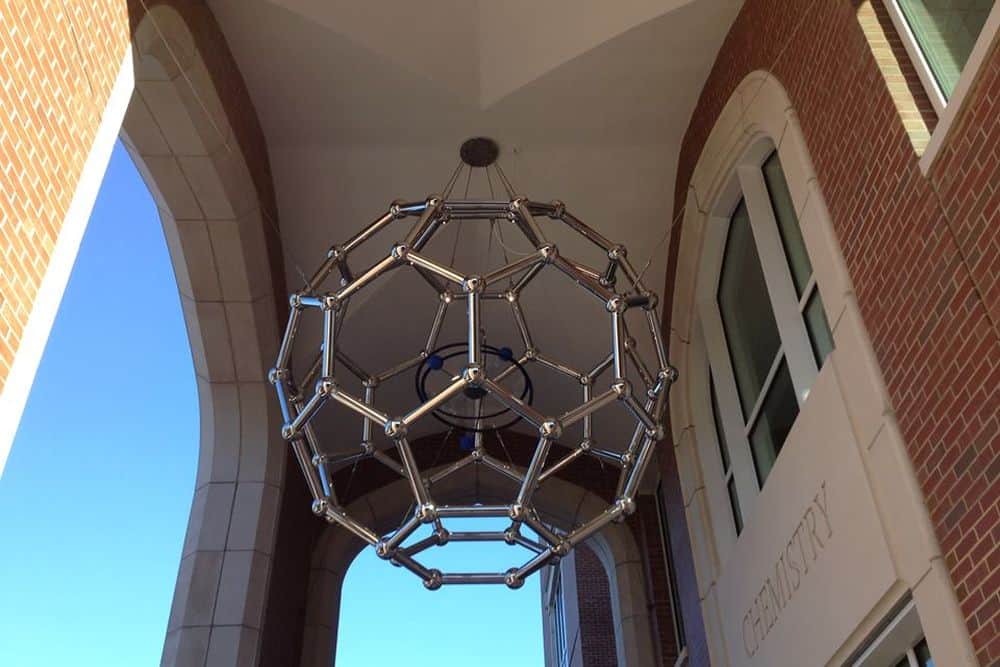
[Image above] Sculpture of a fullerene, a complex form of carbon discovered in 1985. The exploration for new carbon structures is an active area of research. Credit: Cjbow, Wikimedia (CC BY-SA 4.0)
By Laurel Sheppard
Carbon has played an essential role throughout human history, from heating our homes and forges (coal) to recording our thoughts (graphite in pencils).
However, the use of carbon in more complex forms started only recently, with discovery of the first fullerene in 1985. This discovery of closed cage “buckyballs” led to the identification of other structures, including carbon nanotubes in 1991 (hollow cylindrical shells of carbon atoms) and graphene in 2004 (a monolayer of carbon atoms).
As applications for carbon nanostructures flourish, the scientists who made these initial discoveries have received international accolades. Three of the chemists involved with the fullerene discovery received the 1996 Nobel Prize in Chemistry, while two researchers who led the experiments identifying graphene received the 2010 Nobel Prize in Physics.
The exploration for new carbon structures continues, and today’s CTT highlights three discoveries announced during the past few months.
Enter the fullertubes
Sixteen years after the discovery of graphene, researchers led by Purdue University announced a new carbon structure—the fullertube—in a paper published August 2020.
Fullertubes are pill-shaped structures that fall somewhere between spherical fullerenes and cylindrical nanotubes. They essentially consist of two buckyball halves connected by a nanotube midsection.
The first fullertubes consisted of either 90, 96, or 100 carbon atoms. They follow the rule that 12 pentagons and an even number of hexagons can form a closed shell, which allows for an additional number of hexagons.
A two-step chemical separation process allowed scalable quantities of fullertubes to be synthesized with uniform masses, shapes, and properties. This consistency gives fullertubes a leg up on carbon nanotubes, which often are a jumble of random lengths and diameters. As such, fullertubes have great potential as components in electrical circuitry, light-based sensors, or fluorescence imaging of biological cells.
In August 2022, the Purdue-led researchers announced two more fullertube structures, both consisting of 120 carbon atoms. The narrower, longer structure is electrically conductive while the wider, shorter one is a semiconductor, thus expanding applications to transistors and other miniature electronic devices.
Graphullerene: graphene’s ‘superatomic’ cousin
In contrast to fullertubes, which combine fullerenes and nanotubes, a new carbon structure dubbed graphullerene combines fullerenes with graphene.
Researchers at Columbia University and the University of Florida published their paper on graphullerene in January 2023. The material consists of fullerene subunits arranged hexagonally in a covalently interconnected molecular sheet. It is created the same way as graphene, i.e., by peeling ultrathin flakes from a larger three-dimensional crystal (in this case, graphullerite instead of graphite).
The fullerene subunits can be linked together in different ways to produce a variety of magnetic and optical properties, leading to new optical and electronic devices. Graphullerene also displays high thermal conductivity, which means it dissipates heat well and could aid in device miniaturization.
In a Columbia University press release, Columbia chemist and coauthor Colin Nuckolls says, “It is amazing to find a new form of carbon. It also makes you realize that there is a whole family of materials that can be made in a similar way that will have new and unusual properties as a consequence of the information written into the superatomic building blocks.”
Broken fullerenes maintain long-range periodicity
The final carbon structure highlighted today comes from work by researchers at South Korea’s Institute for Basic Science and China’s University of Science and Technology. Their discovery, long-range ordered porous carbon (LOPC), paves the way for the discovery of other crystalline carbons starting from C60 fullerenes.
To create LOPC, the researchers mixed C60 fullerene powder with alpha lithium nitride (α-Li3N). When heated, the α-Li3N acts as a catalyst, breaking some of the fullerene’s carbon–carbon bonds. New carbon–carbon bonds are then formed with neighboring C60 molecules.
The resulting LOPC consists of a string of broken C60 cages bonded to each other. As such, it demonstrates the unusual situation of having long-range periodic order even though not every broken C60 cage is identical to its neighbors.
The researchers see several possible applications for LOPC, including in
- Harvesting, transformation, and storage of energy;
- Catalysis to generate chemical products; and
- Separation of molecular ions or gases.
A long road ahead?
When—if ever—these new carbon structures may be commercialized is a question without a ready answer. Even now, commercialization of graphene, which was discovered almost two decades ago, is hindered by cost and production challenges.
Regardless, these studies demonstrate there is still much to learn about carbon, and our reliance on this material is sure to take new forms in the future.
